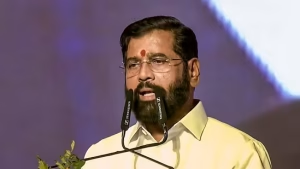During Maharashtra’s annual Dussehra celebrations, Deputy Chief Minister Eknath Shinde announced that his Shiv Sena party would provide comprehensive support to flood-affected farmers, including assistance for their children’s wedding arrangements. This Shiv Sena wedding relief initiative represents a distinctive approach to disaster management, blending traditional social welfare with contemporary political strategy during a critical election period.
Also Read: Shiv Sena wedding relief
Other: Justice Surya Kant CJI
 The announcement came at a politically significant moment, as Maharashtra prepares for electoral contests while simultaneously grappling with devastating flood damage across multiple districts. The state has witnessed crop destruction affecting nearly 60 lakh hectares of land, creating an agricultural crisis of unprecedented proportions that demands both immediate relief and long-term support mechanisms.
The announcement came at a politically significant moment, as Maharashtra prepares for electoral contests while simultaneously grappling with devastating flood damage across multiple districts. The state has witnessed crop destruction affecting nearly 60 lakh hectares of land, creating an agricultural crisis of unprecedented proportions that demands both immediate relief and long-term support mechanisms.
The Scope of Maharashtra’s Flood Crisis
The flooding situation in Maharashtra has left farmers in severe distress, with many losing land, homes, and crops. The Marathwada region, particularly vulnerable to agricultural devastation, has borne the brunt of nature’s fury. Rural communities that depend entirely on agricultural income have found themselves facing financial ruin, with wedding ceremonies and other family obligations becoming impossible burdens during this crisis period.
The government initiated immediate relief measures, providing Rs 10,000 in cash along with essential commodities like rice and wheat to those requiring urgent assistance. However, the Shiv Sena wedding relief program extends beyond conventional disaster response by addressing the social and cultural dimensions of rural life that often receive inadequate attention during emergencies.
Understanding the Wedding Relief Component
The Shiv Sena wedding relief initiative specifically targets families whose children’s marriages were scheduled during or immediately after the flood period. In rural Maharashtra, weddings represent significant financial commitments that families plan for years in advance. When floods destroy crops and livelihoods, these planned celebrations transform into sources of tremendous stress and potential debt.
Deputy Chief Minister Shinde emphasised that for farmers whose children’s weddings are scheduled, if any problems arise, Shiv Sena will stand with them. This commitment acknowledges that disaster relief must encompass more than survival necessities—it must also protect the dignity and social fabric of affected communities.
The Shiv Sena wedding relief program represents an understanding that rural families measure their recovery not merely through restored agricultural capacity but also through their ability to fulfil social obligations. Weddings in Indian agrarian society carry profound significance, representing family hohonourcommunity standing, and intergenerational continuity.
Political Context and Electoral Implications
The timing of the Shiv Sena wedding relief announcement during the Dussehra rally carries unmistakable political overtones. The annual Dussehra Melava serves as a traditional platform for Shiv Sena to demonstrate its commitment to various constituencies, and this year’s focus on agricultural distress reflects calculated political positioning ahead of upcoming electoral contests.
Deputy CM Shinde urged Shiv Sena workers to focus on the upcoming elections and ensure the victory of the Mahayuti alliance by highlighting their work. The Shiv Sena wedding relief program thus functions simultaneously as genuine humanitarian assistance and strategic political messaging designed to strengthen the party’s appeal among rural voters who constitute a crucial electoral demographic.
Critics might characterise such initiatives as election-season opportunism, yet supporters argue that political incentives driving welfare programs don’t diminish their practical value to beneficiaries. The Shiv Sena wedding relief measure may indeed boost the party’s electoral prospects, but it simultaneously addresses real hardships facing flood-affected families.
 Implementation Mechanisms and Party Mobilisation
Implementation Mechanisms and Party Mobilisation
The party flagged off relief trucks from its Mumbai headquarters, carrying essential commodities, medicines, and household items to Dharashiv district, with approximately 50-60 trucks of relief material being sent to different flood-affected areas. This logistical mobilisation demonstrates the organisational capacity required to transform political announcements into tangible assistance.
The Shiv Sena wedding relief initiative leverages the party’s grassroots network, which extends throughout Maharashtra’s rural landscape. Shinde urged Shiv Sena workers to prioritise aiding flood-affected farmers, transforming party cadres into disaster response personnel. This approach integrates political organisation with humanitarian action, creating a delivery mechanism that operates independently of formal government bureaucracy.
Party workers visiting affected areas can identify families requiring wedding assistance, assess their specific needs, and coordinate support accordingly. The Shiv Sena wedding relief program thus benefits from the party’s existing infrastructure and local knowledge, potentially enabling more responsive and culturally appropriate assistance than standardised government schemes might provide.
Comparative Analysis with Government Relief Measures
The government announced it is fully committed to compensating flood-affected farmers and would not let their Diwali be dark. This official promise establishes timelines for assistance delivery, creating accountability mechanisms that citizens can reference when evaluating government performance. The Shiv Sena wedding relief announcement exists alongside these formal commitments, raising questions about the relationship between party-sponsored and government-administered welfare.
Cabinet discussions emphasised helping farmers without paying heed to terms and conditions, acknowledging the government’s responsibility during such crises. However, opposition parties have raised concerns about whether relief distribution might involve political favouritism or be used to strengthen the ruling alliance’s positioning ahead of elections.
The Shiv Sena wedding relief program operates in this complex political environment, where genuine welfare objectives intermingle with electoral calculations. The initiative’s ultimate impact depends on implementation quality, beneficiary selection transparency, and the extent to which assistance reaches those most in need, regardless of political affiliation.
Cultural Significance and Social Impact
Beyond immediate financial assistance, the Shiv Sena wedding relief program acknowledges the psychological and social dimensions of disaster recovery. Families unable to conduct planned weddings experience profound distress that extends beyond economic hardship to encompass shame, anxiety about family reputation, and concerns about their children’s prospects.
In rural Maharashtra, wedding ceremonies serve crucial social functions, strengthening community bonds, facilitating intergenerational wealth transfer, and marking important life transitions. When disasters force families to cancel or postpone weddings, the ripple effects extend throughout communities, affecting social cohesion and collective morale during already difficult times.
The Shiv Sena wedding relief initiative recognises these cultural realities, positioning the party as understanding and respecting rural social structures. This cultural sensitivity may enhance the program’s reception among target communities, building goodwill that transcends immediate material benefits.
 Opposition Response and Political Debate
Opposition Response and Political Debate
Political opponents have questioned whether such targeted assistance represents an appropriate disaster response or constitutes vote-bank politics. The timing immediately before elections inevitably invites scepticism about underlying motivations. Some critics argue that comprehensive crop insurance reform and infrastructure development would provide more sustainable solutions than episodic relief measures.
Opposition parties have demanded complete crop loan waivers and the establishment of all-party committees to oversee flood relief distribution. These alternative proposals suggest different approaches to agricultural crisis management, emphasising systemic reforms over individual assistance programs.
The debate surrounding the Shiv Sena wedding relief announcement thus reflects broader disagreements about appropriate government roles during disasters, the relationship between political parties and welfare provision, and the balance between immediate relief and structural transformation.
Long-Term Implications for Rural Welfare
The Shiv Sena wedding relief program raises important questions about future welfare policy directions. If successful, it might inspire other parties to develop culturally specific assistance programs addressing non-economic dimensions of disaster impact. Alternatively, it might become another temporary election-season promise that fades after voting concludes.
Shinde emphasised that wherever there is a disaster, Shiv Sena is present, and wherever there is a crisis, Eknath Shinde is there—an equation that has existed for several years. This self-characterisation positions disaster response as central to party identity, suggesting that flood relief initiatives like the wedding assistance program represent more than tactical political manoeuvres.
The program’s sustainability depends on institutional mechanisms for identifying beneficiaries, verifying needs, disbursing assistance efficiently, and maintaining accountability. Without robust implementation systems, even well-intentioned announcements risk becoming empty promises that increase public cynicism about political commitments.
Conclusion: Balancing Politics and Compassion
The Shiv Sena wedding relief announcement exemplifies contemporary Indian politics’ complex intersection of genuine welfare concern and electoral strategy. While critics legitimately question the timing and motivations behind such initiatives, beneficiaries struggling with the flood aftermath likely welcome any assistance regardless of political calculations driving its provision.
The program’s ultimate significance will emerge through implementation quality and whether it establishes precedents for more culturally sensitive disaster response mechanisms. If the Shiv Sena wedding relief initiative successfully helps families maintain dignity during crisis periods, it may represent valuable innovation in welfare policy, despite—or perhaps because of—its political origins.
As Maharashtra navigates both natural disaster recovery and electoral competition, initiatives like this wedding relief program will continue generating debate about appropriate relationships between political action and humanitarian assistance. The challenge for all stakeholders involves ensuring that political incentives enhance rather than undermine effective disaster response, creating systems where electoral pressures drive genuine welfare improvements rather than merely symbolic gestures.
The Shiv Sena wedding relief program thus stands as both a practical assistance measure and a test case for politically motivated welfare initiatives. Its success or failure will offer valuable lessons about disaster response, political accountability, and the complex dynamics shaping contemporary Indian governance.

